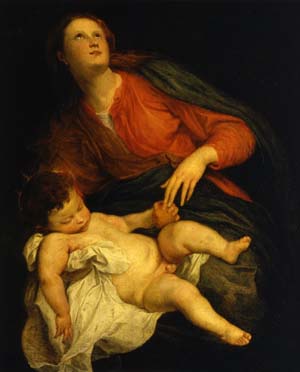Anthony van Dyck produced several versions of this famous Christian theme, many of which have survived to the present day
This particular painting is loosely dated at 1621–27, meaning the artist would have been in his early to mid twenties when completing it. At that stage he will have finished his tutorship from Peter Paul Rubens and was starting to develop his own unique style for the first time.
Religious themes were more common in the earlier years of this artist, with Van Dyck later building some strong connections with donors who would often request portraits of themselves instead. It was standard for any budding artist to experiment with different genres in the early years to find out what they enjoy and where they most excel. The earlier Renaissance had also been dominated by religious themes and the baroque periods were just starting to move in new directions.
The intriguing aspects of this painting are the way in which the Madonna looks to the heavens, and also the size of the baby, larger than you might normally see. The light is carefully placed across the two characters in this scene, with pure darkness falling on the background. The focus is forced upon the titled figures. Perhaps this painting has been unvalued compared to others in his ouevre, but it is still highly significant.
This lesser known artwork from Van Dyck can now be found at the Galleria nazionale di Parma and is one of the few paintings from his career to reside in Italy, despite his fondness for the country and frequent trips to what was then known as the Papal States. This significant art institution also holds work by the likes of Canaletto, Correggio, Sebastiano del Piombo, Leonardo da Vinci, Parmigianino, Annibale Carracci, El Greco, Tintoretto, Fra Angelico and Hans Holbein.




